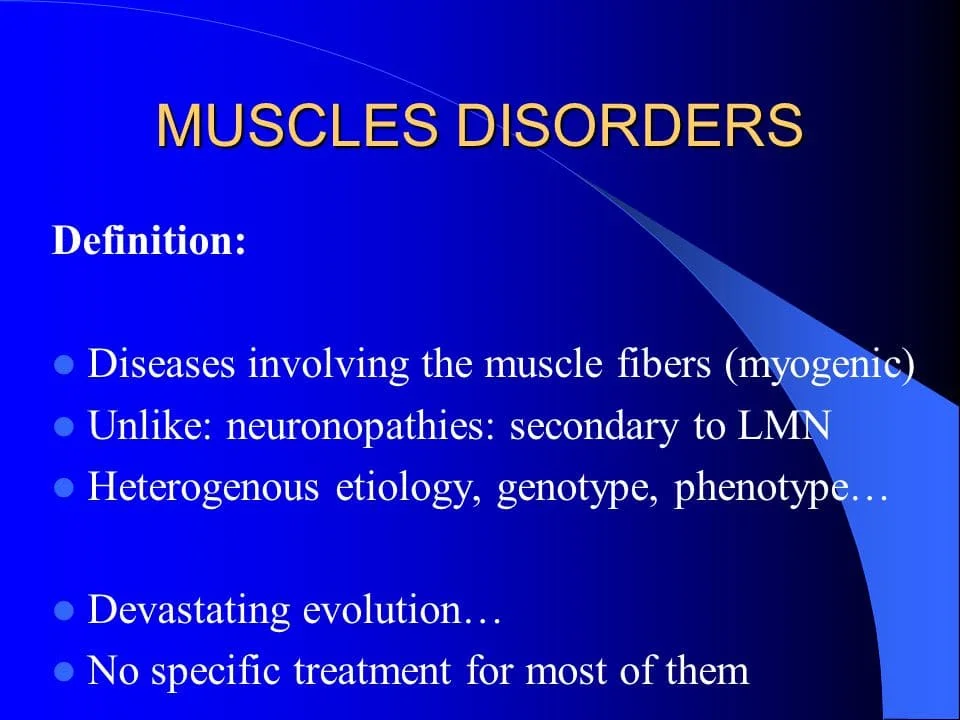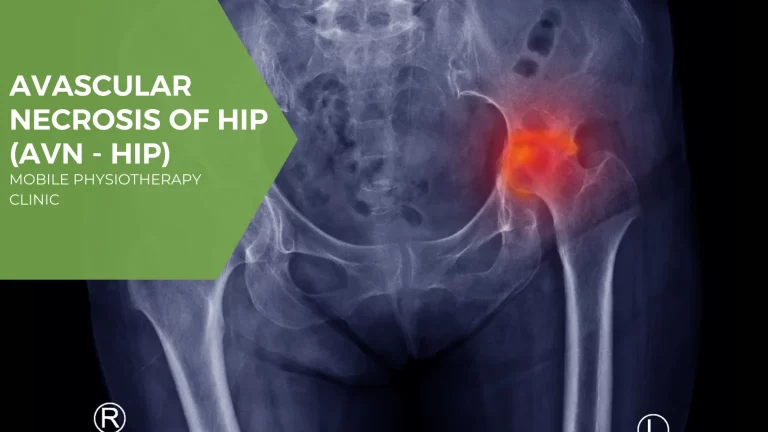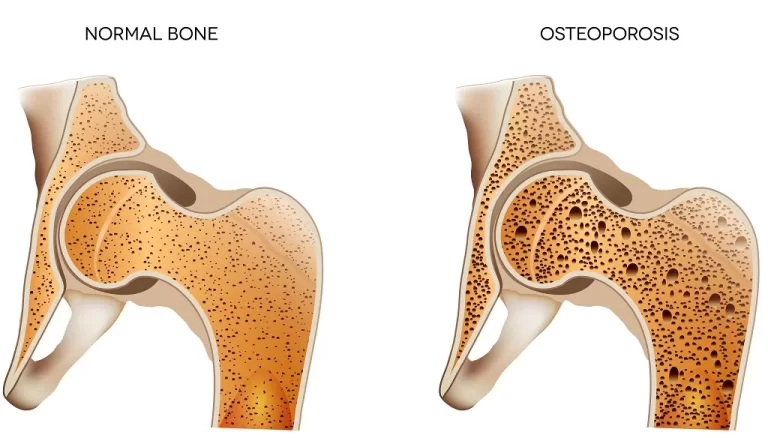Muscle Disorders
Table of Contents
What is a Muscle Disorders?
Skeletal muscular weakness is the primary symptom of illnesses and disorders that affect the human muscle system, known as muscle disorders. The phrase “muscle disorders” encompasses the words “muscular dystrophy,” “neuromuscular conditions,” and “neuromuscular disorders.”
These illnesses comprise a broad range of ailments that impact either the nerves that govern the muscles (e.g., arms, legs, heart, lungs) or the muscles themselves. Under conditions where the neurological system is intact, disorders of the muscles may result in weakness or paralysis.
Classification of Muscle Disorders
Muscle diseases can be categorized according to:
- Primary or secondary: Conditions resulting from direct abnormalities of the muscles, such as polymyositis, are classified as primary muscle illnesses. And conditions that may have resulted in muscle degeneration but are secondary to another condition, such as endocrine disorders.
- inherited or acquired
- neurological disorders or myopathies
Causes of Muscle Disorders
Muscle problems can be caused by
- inherited, age
- Overuse or injury, such as tendinitis, cramps, or sprains or strains
- a hereditary condition like muscular dystrophy
- Certain cancers
- inflammatory conditions like myositis
- disorders affecting the nerves in the muscles
- Infectious diseases
- Some medications
- Endocrine and metabolic factors
- autoimmune conditions
- Sometimes the etiology may not be known.
Symptoms
The symptoms of various muscle disorders differ from one another.
Symptoms may include:
- Muscle weakness that slowly gets worse.
- breathing issues, especially dyspnea (shortness of breath)
- dizziness,
- Fatigue
- Muscle wasting, loss of strength
- high fever,
- a stiff neck.
- Numbness, tingling, or painful sensations
- Double vision
- Droopy eyelids
- Problems with swallowing—dysphagia
- muscle weakness
- Problems walking, balance, and frequent falls
Types Of Muscle Disorders
Common types of Muscle Disorders include:
- Myopathies, such as Duchenne Muscular Dystrophy, Polymyositis, Dermatomyositis, and Steroid-Induced Myopathy
- Cramp: a prolonged, painful, involuntary skeletal muscular contraction
- Inflammation of the muscles’ fibrous connective tissues is known as fibrositis. It also affects the back and trunk muscles.
- Myasthenia Rhabdomyolysis Gravis
- Heart Myopathy: Disease of the Coronary Arteries
- Loss of Amyotrophic Laterality
- Sarcopenia: Primary or secondary, this illness affects the muscles. Muscle mass and strength are lost in sarcopenic patients.
Diagnosis
Usually, the patient, their family, or a doctor notices a muscular weakness, which leads to the initial suspicion.
The following tests can be used to identify muscle disorders:
- An electromyography, or EMG, is a recording of a muscle’s electrical activity. It is capable of diagnosing degenerative illnesses, motor and nerve issues, and muscular difficulties.
- A blood test that measures certain antibodies and muscle enzymes that may be unique to one or more disorders
- A muscle biopsy uses a local anesthetic to remove a small sample of muscle. The sample is investigated under a microscope, and tests may be performed on the muscle chemicals (proteins).
- Genetic analysis: this entails utilizing a blood sample to examine a person’s DNA. It can identify most, but not all, MD cases.
- MRI: to display atypical muscle regions
- To check for suspected CMD, muscle ultrasonography is utilized.
Treatment
Muscular diseases do not yet have a cure, however, some therapies can help control the problem. Treatment for muscular disorders may include the following objectives:
- treating symptoms,
- delaying disease progression, and
- improving quality of life
Medical Management
Sometimes doctors will prescribe oral corticosteroids to treat cramps and spasms.
Certain disorders of the muscles and nerves, as well as ailments affecting both the muscles and nerves, may be treated with immunosuppressants, and medications that limit or prevent the immune system from being overactive.
If necessary, surgical adjustments could be suggested. The individual needs to be as engaged as they can be. Total immobility, such as being in bed, can exacerbate the illness
Physiotherapy Management
The physical therapist works with a multidisciplinary team; some conditions require long-term care.
The Physical therapy goals may include:
- boosting initiative
- Pain Control
- Treatment of contractures: stretches, exercises, and, if necessary, night splints
- Hydrotherapy and swimming
- Setting up modifications for the house
- Program for Respiratory and Heart Rehabilitation
- Training balance
Conclusions
The existing agreement that the majority of risk factors account for just a tiny share of TMJMD in the population is supported by this review.
However, among individuals exposed to certain risk factors, some variables may account for a substantial amount of TMJMD.
The prevailing agreement that prevention—screening the population for risk indicators and taking appropriate action—is probably not warranted is supported by this research.
It may be necessary to change a few risk factors in those who are exposed to avoid TMJMD.
To assess the significance of risk factors for the development and prevention of TMJMD in the general population as well as in individuals who have been exposed, incidence statistics and epidemiologic measures of risk are required.
FAQ
Common muscular system disorders are:
Amyotrophic lateral sclerosis (ALS)
Charcot-Marie-Tooth disease.
Multiple sclerosis.
Muscular dystrophy.
Myasthenia gravis.
Myopathy.
Myositis, polymyositis, and dermatomyositis.
Peripheral neuropathy.
A type of genetic condition known as muscular dystrophy is typified by weakness and the withering away of muscle tissue, either with or without the degeneration of nerve tissue. Muscular dystrophy comes in nine different forms, each of which can result in a deformity, an eventual loss of strength, and an increase in handicap.
electromyography. The muscle that will be evaluated is punctured with an electrode needle. Measuring electrical activity occurs during both relaxed and slightly tightened muscular contractions. An illness of the muscles can be verified by alterations in the electrical activity pattern.
Main Muscle Disorders
An inflammation of the muscles and the tissues that surround them, including the blood vessels, is called myositis.
One kind of autoimmune neuromuscular illness is myasthenia gravis (MG).
Another name for amyotrophic lateral sclerosis (ALS) is Lou Gehrig’s illness.
A class of disorders known as muscular dystrophy results in gradual weakening and loss of muscle mass. Mutations in some genes cause muscular dystrophy by interfering with the formation of proteins necessary for the proper structure of muscle. Multiple types of muscular dystrophy exist.
Inflammation of the muscles’ fibrous connective tissues is known as fibrositis. It also affects the back and trunk muscles. Sarcopenia: Primary or secondary, this illness affects the muscles. Muscle mass and strength are lost in sarcopenic patients.
Muscle Disorders
A sprain or strain, cramping, or tendinitis are examples of an injury or overuse.
An inherited illness like muscular dystrophy.
Some cancers.
Swelling, such as myositis.
Illnesses of the nerves that impact the muscles.
Infections.
Certain medications.
Signs and symptoms
Muscle weakness, stiffness, loss of control, tingling, twitching, spasms, muscle pain, and some forms of limb pain are some of the symptoms of muscle illness.
To address the underlying cause of your muscular weakness, a prescription for medication may be given. Thyroid treatments are used to treat thyroid issues while pain-relieving and anti-inflammatory drugs can assist in reducing nerve irritation that can cause muscular weakness.
Common causes of muscular weakness include aging, pregnancy, injuries to the muscles, and inactivity. Long-term illnesses like diabetes or heart disease might also cause it. Numerous other conditions might also be the reason, such as depression, fibromyalgia, multiple sclerosis, stroke, and chronic fatigue syndrome (ME).
A vitamin D deficiency occurs when your body does not have enough of the vitamin, which can lead to health issues including weak muscles and brittle bones. Many people are deficient in vitamin D and are unaware of it since there may not be any symptoms and doctors do not often check vitamin D levels.






